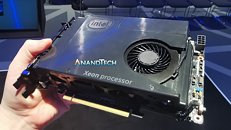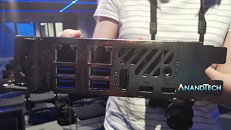Tuesday, October 8th 2019

Intel Readies "The Element" - a Next-Generation of Modular PCs
Yesterday Intel hosted an event in London, where it held a presentation and demonstration of new concept product. Simply called "The Element", this new products tries to introduce the concept of modular computing, where you can basically swap out parts and replace them with ease, to users of PCs who wanted this to happen for a long time.
If anyone remembers Razer's project Christine, which unfortunately didn't take off, this product should be of no surprise to them. The Element is a complete PC consisting out of CPU, RAM and Storage, with a PCIe slot attached to it. Featuring plenty of IO options like Thunderbolt, HDMI, Ethernet, USB, and Wi-Fi, The Element is a complete solution for computing. For the demo Intel soldered a BGA Xeon CPU with room for two SODIMM slots for memory and two M.2 ports for storage expansion, all cooled by a blower fan directly cooling the CPU heatsink. Power is supplied from PCIe slot (75 Watts) and 8 pin connector which would come from a regular PSU. There is also an option for the card to be powered by a 19 V power source if external power brick is provided.As you can see from the above images, this concept basically wants to put all the computing power on a card that attaches to the single motherboard with a PCIe slot. Such approach would allow for some interesting solution when it comes to the design of a system, where you could build anything from small form factor PCs all the way to the giant builds that feature dozen or so of these units in order to form a server like unit. Possibilities for configuring the system based on "The Element" are almost endless.
While this comes as a PCIe card, there would be no regular AIB partners to release their own PCB design. Instead AIB partners would just be allowed to make small aesthetics adjustments like different cooling type (watercooling anyone?) and different designs of backplates.While in the development phase for now, this concept is planned for release sometime in Q1 2020, most likely availability will be at the end of Q1 or beginning of Q2. Pricing is still unknown and configurations of this product will be OEM dependant, so that still remains a mystery until further notice.
Source:
AnandTech
If anyone remembers Razer's project Christine, which unfortunately didn't take off, this product should be of no surprise to them. The Element is a complete PC consisting out of CPU, RAM and Storage, with a PCIe slot attached to it. Featuring plenty of IO options like Thunderbolt, HDMI, Ethernet, USB, and Wi-Fi, The Element is a complete solution for computing. For the demo Intel soldered a BGA Xeon CPU with room for two SODIMM slots for memory and two M.2 ports for storage expansion, all cooled by a blower fan directly cooling the CPU heatsink. Power is supplied from PCIe slot (75 Watts) and 8 pin connector which would come from a regular PSU. There is also an option for the card to be powered by a 19 V power source if external power brick is provided.As you can see from the above images, this concept basically wants to put all the computing power on a card that attaches to the single motherboard with a PCIe slot. Such approach would allow for some interesting solution when it comes to the design of a system, where you could build anything from small form factor PCs all the way to the giant builds that feature dozen or so of these units in order to form a server like unit. Possibilities for configuring the system based on "The Element" are almost endless.
While this comes as a PCIe card, there would be no regular AIB partners to release their own PCB design. Instead AIB partners would just be allowed to make small aesthetics adjustments like different cooling type (watercooling anyone?) and different designs of backplates.While in the development phase for now, this concept is planned for release sometime in Q1 2020, most likely availability will be at the end of Q1 or beginning of Q2. Pricing is still unknown and configurations of this product will be OEM dependant, so that still remains a mystery until further notice.



41 Comments on Intel Readies "The Element" - a Next-Generation of Modular PCs
At 7am!!!! I think you means "will host"!
Can't see the point here really... By the time you need an additional module, the original one is not compatible (Intel ftw), or the enclosure conector is 1 or 2 gen's old...
Think back to the backplane systems. Was that realy a good solution?
As others have said, knowing Intels history with sockets, you will replace the whole machine when upgrading in 2 years.
This project is about a more general concept of modular PCs, where only the CPU and RAM are fixed - everything else being easily changed. People have been looking forward to this for years (decades...).
I guess that's my point: why PCI Express? It should be using a new interconnect that facilities all types of high speed communication (CPU to CPU, CPU to AIB, AIB to RAM, etc.) and power delivery. I see nothing really revolutionary here. Certainly not a milestone for future products. All they did is basically flip PCI Express around (put the host on a card).
I feel like they were leaning this way at one point then bailed for PIII.
R- the FPGA
V- the AI co-processor
And the regular, which is actually not a co-processor, but two complete PCs with RAM & storage on a single PCB. You can do whatever you want with these cards, cause basically they are interfaced via 10GbE. There are two chips on the board(probably older Intel or Mellanox), which are wired directly to PCIe on the slot side, and NIC on the SoM side. You talk and manage those over the network, even though there are no cables.
So, you can deploy even something like a homebrew OpenMPI cluster or virtualized workspaces for relatively cheap.
www.qnap.com/en/product/mustang-200/specs/hardware
But the principle stands. The idea of modular PCs is not about combining few separate machines. It's just a change of approach to how we make DIY setups. The goal being: to make it fast and very easy. It should be as simple as attaching an external USB drive, so that anyone could do it.The point is: building DIY PCs will be as easy as connecting a multi-deck stereo system. Just a few cables.What do you mean? PCIe has enough bandwidth today. The modular concept isn't much different from what we have today. It's just that every larger component will have "a box" and there will be more "risers".CPU and RAM will always come together, because distance and compatibility are crucial for performance.
Seriously, imagine a laptop with attached external drives, eGPU, external network card, external sound card.
It works even today.
The idea here is really just to replace the USB cables with a shorted, more robust and much faster bus.
Building DIY desktops today is beyond what most can or are willing to do. With modular PCs they'll just push one big box into a slot next to other boxes. It'll be as easy as assembling a food blender.